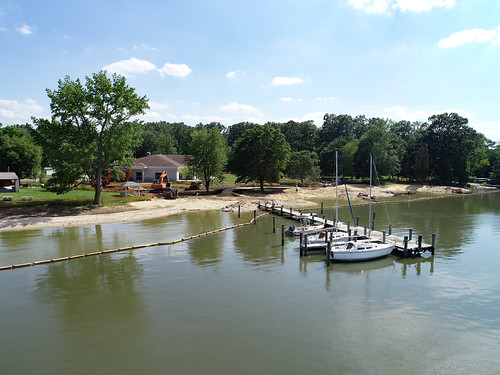Resiliency Through Restoration Program Breaks Ground at Church Camp
Living Shoreline and Wetland Installation in Anne Arundel County

Photo by Stephen Badger/Maryland Department of Natural Resources
The Maryland Department of Natural Resources (DNR) announces resilient shoreline and wetland features are being installed at the West River United Methodist Center, a camp and outdoor recreation facility in southern Anne Arundel County. This groundbreaking is the first of numerous projects supported by Governor Hogan’s Resiliency through Restoration Initiative.
This innovative restoration project is located on the West River in an area vulnerable to flooding, erosion, and coastal storm impacts. An 885-linear-foot living shoreline with vegetated breakwater and cobble beach components is being constructed to address rising tides, replace a failing bulkhead, enhance wildlife habitat, and help protect infrastructure from storm surge and coastal impacts. These natural features are complemented by 430 linear feet of regenerative stormwater conveyance wetland, designed to safely convey stormwater through the campus and to the shoreline.
The initiative supports restoration targeting, design and construction of nature-based projects, monitoring, adaptive management, community outreach and education – all activities necessary for community-driven restoration and resilience.
“Under the Governor’s leadership, Maryland launched the Resiliency through Restoration Initiative to find smart solutions for flooding and other weather and climate impacts in our coastal communities,” Secretary Jeannie Haddaway-Riccio said. “These demonstration projects maximize the use of nature-based green infrastructure solutions such as living shorelines, dunes and wetlands as an important line of defense for coastal and community protection.“
The project site is managed by the Baltimore-Washington Conference of the United Methodist Church, which includes environmental education in its summer camping program. The camp typically hosts more than 10,000 visitors from school-aged children to adults participating in camp, conference, and club events.
“The living shoreline project is a win-win all around,” says Chris Schlieckert, Director of the West River Center. “When a camper or guest comes to The West River Center, our goal is for them to experience and grow in their love of God, self, neighbor, and nature. The living shoreline helps us achieve each of these goals by enhancing the beauty of the shoreline and helping our guests feel connected with the water. It provides educational opportunities as a part of our nature center programs with young people. And of course, it helps us be better environmental stewards by providing habitat, improving water quality, and advancing shoreline resiliency.”
In addition to the center, project partners include DNR Chesapeake and Coastal Service, Alliance for the Chesapeake Bay, and project contractors Underwood and Associates and Sustainable Science.
Resiliency through Restoration projects are solicited annually through the DNR Grants Gateway. Current resilience projects are in various stages of development and include:
- Anne Arundel County, Deale Beach Community – living shoreline project
- Anne Arundel County, City of Annapolis, St. Mary’s Church – living shoreline project
- Anne Arundel County, Franklin Point State Park – living shoreline project
- Anne Arundel County, Longview on the Magothy – living shoreline project
- Anne Arundel County, Honeysuckle Drive – living shoreline project
- Dorchester County, Hurst Creek – living shoreline and beneficial use project
- Prince George’s County, Town of Eagle Harbor – stream restoration project to address flooding
- Prince George’s County, Hyattsville – submerged gravel wetland green infrastructure project to address urban flooding
- Queen Anne’s County, Chesapeake Bay Environmental Center – Marsh enhancement and beneficial use project
- Somerset County, Deal Island Peninsula – living shoreline and marsh enhancement.
- St. Mary’s County, Myrtle Point Park – coastal resilience and living shoreline project
- St. Mary’s County, St. Catherine’s Island – living shoreline project
- St. Mary’s County, Piney Point Lighthouse — living shoreline project
- Talbot County, Tilghman on the Chesapeake Community— living shoreline and stormwater pilot project for the County Green Infrastructure Plan
- Talbot County, Town of Oxford – living shoreline and stormwater enhancement project
- Worcester County, Selsey Road– living shoreline and marsh project
- Worcester County, Swans Gut Creek – floodplain reconnection and stream connectivity project
- Worcester County, Tizzard Island – living shoreline, marsh enhancement and island resilience project
